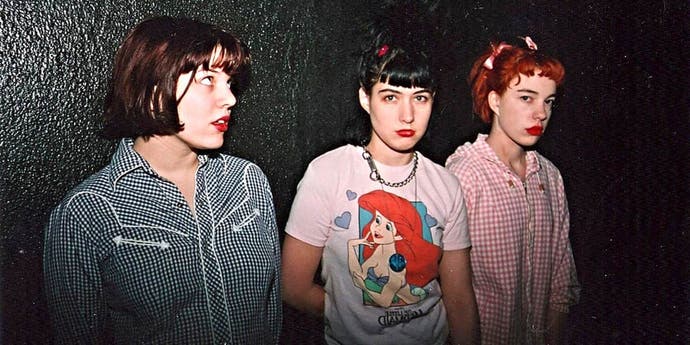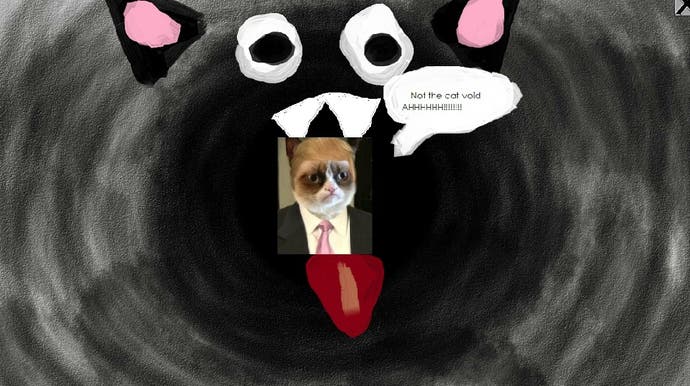The Riot Grrrl spirit comes to video games
Girls to the front.
My fellow music nerds will remember Riot Grrrl for its connection to a wellspring of awesome bands. From Bikini Kill to Bratmobile and Heavens to Betsy, at the start of the 1990s the Washington punk scene had suddenly exploded in girl bands, pouring out of a growing movement of informal all-girl meet-ups in the city where women of the scene organized shows, offered each other support and distributed zines - hand-crafted magazines filled with Xeroxed diary entries, sketches, song lyrics and political thought. In a world before the Internet, this was the best way to cultivate a community of like-minded thinkers who felt excluded from what was a predominantly masculine preoccupation of punk rock.
As both a child of the 90s and someone who has spent the last decade in games journalism, it's hard not to see a parallel between the Riot Grrrl of yesterday and the games and tech industry of today. Both punk and nerd kingdoms represent a counter to the tastes, views and expectations of the mainstream - a place where outcasts can find an alternative home and commune with those who share their interests. However, as women and other minority figures of the punk community came to realize, here too they were sidelined.
In the second issue of her zine Chainsaw, musician Donna Dresch writes about this climate in the punk scene right around this time:
"Right now, maybe Chainsaw is about Frustration. Frustration in music. Frustration in living. In being a girl, in being a homo, in being a misfit of any sort. In being a dork, you know the last kid to get picked for the stupid kickball team in grade school. Which is where this whole punk rock thing came from in the first place. NOT from the Sex Pistols or L.A. But from the GEEKS who decided or realized (or something) to "turn the tables" so to speak, and take control of their (our) lives and form a Real underground."
It's 2018 and while diversity talks have been a tradition in the games industry for some time, I think it might be too early to kick our feet up. Published earlier this year, the most recent report from the International Game Developers Association Developer Satisfaction Survey notes that 42 per cent of respondents said the game industry had increased its diversity over the past two years, a drop down from 47 per cent the year prior. Similarly, of the full-time employed respondents, 14 per cent reported that their company had no policies directed toward diversity or equality, and another 25 per cent didn't know if their company had any diversity-related policies. The loneliness of the lone-diversity-hire is, I think, somewhere on a par with the girls who line the perimeter of the mosh pit, unable to truly enter the foil.
Lisy Kane is one of the originators of Girl Geek Academy, an Australia-based collective of lady professionals in the tech industry, who develop projects aimed at growing the number of women-who-make-things in tech. Kane, a game producer in Melbourne, is curator of events like #SheMakesGames and #MissMakesCode - the latter introduces code to girls between 5 and 8, around the same time as reading and writing so that code too can become a native skill.

"I met my Girl Geek Academy co-founders while working on various 'women in tech' initiatives," Kane tells me. Her soon-to-be GGA co-founder Tammy Butow had just launched the world's first all-women hackathon, #SheHacks. After seeing the results, Kane says they were inspired to found Girl Geek Academy " to help build communities and support networks surrounding women in tech," adding: "we were sick of being the only women in the room and we worked out pretty quickly we could help change that situation."
"We know that almost half of video game consumers are women, and many want to play diverse games developed by diverse teams. The problem is that there is a lack of opportunities for women to develop their skills in the industry."
Australia's games industry is up to just 18 per cent female workers. The IGDA's current worldwide survey - based on a response pool from 963 developers - isn't much better. While the percentage of women in the game development workforce almost doubled from 11.5 to 22 per cent between 2009 and 2014, that upward climb not only halted but took a minor fall to 21 percent last year.
Kane's methods for solving this problem remind me of the work initiated by Kathleen Hanna, Tobi Vale, Carrie Brownstein and other figureheads of the Riot Grrrl scene. Both grassroots efforts instigated by and for women, both offering a helping hand over a threshold of a Boy's Club.
"There are now more women than ever before standing up as role models in the industry to show the next generation that a game developer looks just like them," says Kane. "It's these small changes that will have an accumulative effect going forward."
Keira Palmer is a superstar, a shining success stories of this seachange. At 13 years old, she is already a two-year veteran of video game design. Palmer was 11 when she created her first short video game, Attack of the Killer Zombie Cats: USA Edition, a point-and-click adventure developed over an 18-hour period during One More Story Games' 2016 summer camp - an intensive week-long course where kids under-16 learn to make their own game using the camp's proprietary development engine StoryStylus.
StoryStylus was developed as a way to help lower the barrier to entry of game development and teach the moving parts of storytelling. Imagine a fancy word processor: it breaks down the elements of story in pieces - people, places, things, conversations, and so on. Students learn the basics of Lua script - a common programming language - and are introduced to game logic and branching narratives.
"We started our very first camps the summer of 2015, when I put out a call among friends on Facebook who had children aged 12-16 who might like to make some video games for the week," says Jean Leggett, CEO at One More Story Games.
Established in Barrie, Ontario by Leggett and her husband Blair, a former software engineer for Electronic Arts, One More Story summer camp had humble beginnings. In 2015, says Leggett, "We had four available workstations.
"Truthfully, we are not trained as educators. But we're patient and passionate people who treat youth like their ideas are valid and valuable." One More Story has since received sponsorship from Paypal and Shopify among others. By its second year, the camp reached a 50/50 ratio of boys and girls looking to flex their muscles in game development.
Adds Leggett: "If we can inspire young girls to create games, then the industry as a whole benefits."

"We teach kids the nouns of storytelling and one of our exercises is to play the card game Once Upon a Time," says Leggett. "They get the feel for the building blocks of the story which we incidentally also use as the framework or nouns of our game engine.
"Next they get some one on one time with a game designer to do a game flowchart of their game and they start writing the game itself. Since we only really have 4-5 hours of game development time per day and 5 days to do it all in, we don't get to do things like a game design document or a marketing plan which I think would be a great addition - it would further expand on their thinking about their audience."
Keira's game, which is about 10 minutes long, takes place during a dystopic invasion of zombie cats that leave only a few alive. You play as either Michelle or Barack Obama, who aims to get to the bottom of this zombie cat stuff by combining inventory items and escaping a mysteriously cat-eared Hillary Clinton, all drawn by Keira. Final Boss Donald Trump is Grumpy Cat with suit and tie and comb-over. "Yo brah!" quoth Trumpy Cat, as the Obama of your choosing enters his tower. "What are you doing here?" he asks, before he meets his end by plummeting into the infinite cat void. It's very funny; it's very silly - informed by memes and a diet of growing-up-with-modern-politics. But most importantly, it's voiced by a girl who, had she been born a decade earlier would not have had these same opportunities to learn to code.
"Girls to the front" was a phrase repeated by Kathleen Hanna throughout her Bikini Kill career. At a keynote in 2011 she described the reasoning behind it: "We were selfishly trying to build a community so we had other girls and women to play with," she says. "And that was only going to happen if we had girls and women in the front row who could see how we were playing our instruments and could see how easy it was."
While the movement came to an end by the late 90s, its eponymous Riot Grrrl manifesto - written by Kathleen Hanna and published in the Bikini Kill zine in 1991 - remains one of the most potent call-to-arms for aspiring Riot Grrrls of any industry:
BECAUSE we see fostering and supporting girl scenes and girl artists of all kinds as integral to this process.
BECAUSE we see fostering and supporting girl scenes and girl artists of all kinds as integral to this process.
BECAUSE I believe with my wholeheartmindbody that girls constitute a revolutionary soul force that can, and will change the world for real.
Riot Grrrl's fundamental message - that the ideas and artistic impulses of girls are valuable - has proven to be as necessary now as it ever was.



